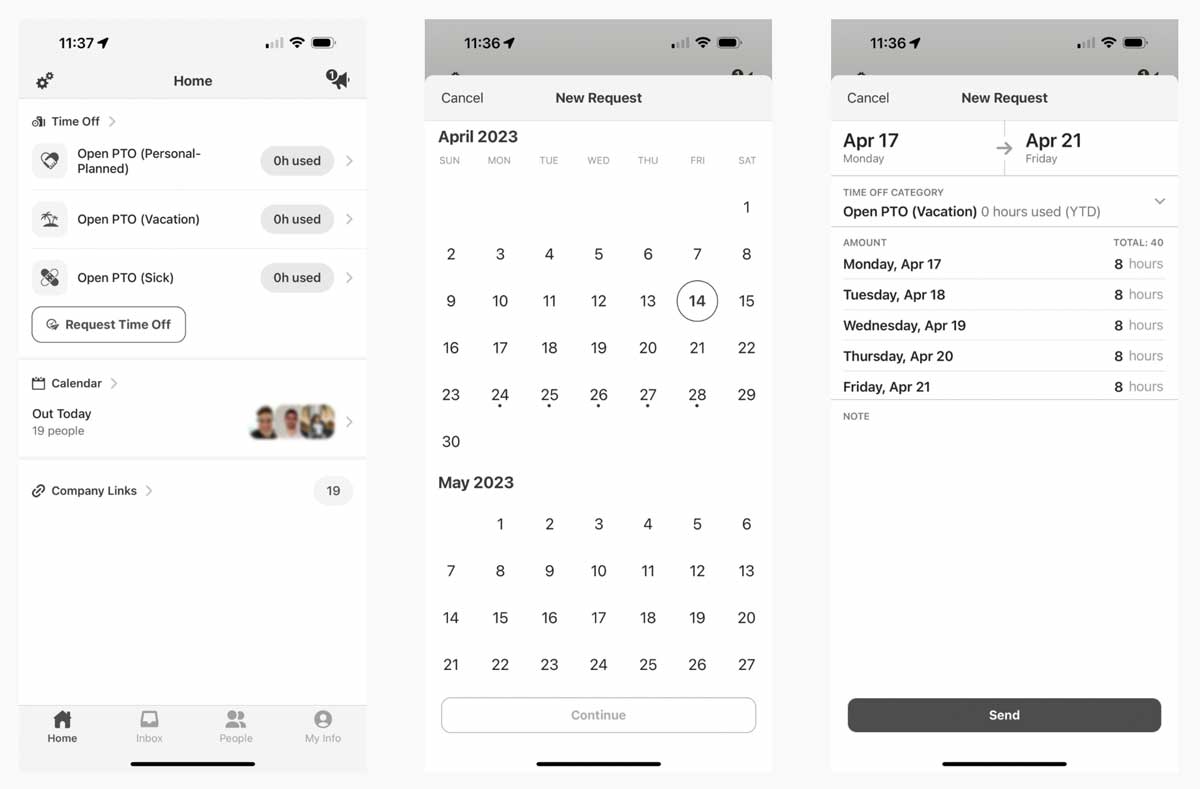We may earn money when you click on links to our partners. Advertiser Disclosure
One of the most significant factors in an employee’s productivity is how much time they are actually at work. This is where accurate time tracking and attendance tools come in.
According to the U.S. Bureau of Labor Statistics, in 2022, the rate of full-time, salary employees absent on any given workday was 3.2 percent. As a company, you want a much lower rate than this. A rate of 1.5 percent is considered a benchmark for absenteeism. Why?
Absent employees cost you directly and indirectly. According to SHRM.org, direct costs include increased wages and overtime costs to pay for replacement workers – some of who will incur overtime. Indirect costs include manager and supervisor stress of finding employees to cover shifts and a significant loss of productivity.
“I strongly believe that implementing an employee time tracking and attendance system is crucial for maintaining productivity and accountability in the workplace,” says Shirley Borg, Head of Human Resources of a team awarded with the HR Quality Mark by the Foundation for Human Resources Development (FHRD), Energy Casino.
“Implementing an employee time tracking and attendance system is crucial for maintaining productivity and accountability in the workplace.”
Below we’ve outlined some time and attendance tracking best practices to ensure your employees reach maximum productivity.
1. Know Your Absentee Rate
Decreasing your absentee rate is important to increasing your employee’s productivity.
It’s important to note that there are planned absences, like an employee taking vacation time, and unplanned absences, such as an employee simply not showing up, calling off unexpectedly, or arriving late on a given day.
You’re looking for the absentee rate or the rate of employees unexpectedly not showing up.
Absentee Rate Formula
To calculate an absentee rate for a given employee, use the following basic formula:
Absentee rate = number of absences / number of workdays x 100
But let’s break that down more. You can find the absentee rate per week, per month, or per year.
The number of workdays in this calculation does not include days employees are not scheduled to work, such as weekends, holidays, etc.
If we calculate a monthly absentee rate and there are 31 days total in the month, you would subtract weekends.
Let’s say, for example, there are eight weekend days and no holidays in the month. Your total workdays for the month are 23.
The formula would look like this: Absentee rate = 2/23 = 0.0869 x 100 = 8.69%
That’s pretty high, but there are some ways you can decrease it. Let’s take a look.
2. Decrease absenteeism
There are many ways that you can decrease absenteeism time. Aside from encouraging employees to take planned time off that you can schedule ahead of time and vacations where they can recharge and avoid burnout, you can also try some of the following tactics:
Offer PTO
Offering paid time off (PTO) gives employees time to use on non-sick days, prompting them to plan ahead instead of just calling in unexpectedly when they want time off.
Provide Incentives
Recognize employees that don’t have absences. This can be as simple as congratulating them in a meeting or as big as giving them a cash bonus, gift card, or extra PTO hours. Whatever will motivate your employees to keep up perfect attendance.
Improve Employee Morale
It’s pretty simple. A more positive employee morale, the more likely your employees are to want to come to work. This can be achieved in a number of ways including holding regular one-on-one meetings to ensure employees feel seen and heard, giving employees the tools to ask for feedback, training managers to be better coaches, and scheduling virtual or in-person team-building activities.
Pay Fair Wages
Paying fair wages for the position means that your employees aren’t disgruntled, care more about their job performance, and are less likely to miss work. Has it been more than a few years since you evaluated what you’re paying for a particular role? It could be time to reevaluate and make your offering more competitive. Employees that are paid fairly will be less likely to call off work to search for a higher-paying position.

3. Communicate attendance expectations
A clear and well-written attendance policy shared during onboarding emphasizes your attendance expectations right from the start. Communicating this can be done through your HR software or learning management software with your other onboarding and training materials.
“It is important to have clear policies and expectations communicated to employees,” Borg says. “We have implemented an attendance policy that outlines our expectations regarding punctuality, attendance, and the steps to take if an employee needs to take time off. We also encourage employees to communicate with their managers if they are unable to attend work for any reason, as it helps us to plan and ensure that the work is still being completed in a timely manner.”
“Encourage employees to communicate with their managers if they are unable to attend work for any reason.”
4. Use software your employees will embrace
The use of time-tracking and attendance software is imperative to the success of your time and attendance best practices. It makes tracking and reporting time and attendance more manageable and more convenient for managers to plan for employee time off and absences.
“Time tracking software makes it easy for employees to clock in and out away from the office and managers can easily approve timesheets,” says Kenny Latimer, Group Product Marketing Manager, BambooHR.
Select a group of employees and managers to test and weigh in on any new software you’re considering for this task.
“The easier the time tracking system, the better it is for both the employees and managers. It is important to have a system that employees can easily access and use, without requiring too much training or additional work,” says Borg.
Get Started FreeVisit BambooHR’s website.
5. Go mobile
Everything is done from our phones these days, and instead of having a form employees fill out to request schedule changes, take it all online with a cloud-based system and a mobile app. BambooHR offers a mobile platform that appeals to traditional, hybrid, and remote employees.
“The great news for both admins and employees is that we also offer a mobile app. Employees can request time off, clock in and out, view personal info, and call co-workers directly from the app,” reports Latimer.

With the BambooHR mobile app, you can see who’s out of the office and request time off without having to log in to your computer. Source: User photos
6. Automate compliance regulations
Time tracking and employee scheduling software will help you stay within workforce compliance. The U.S. Department of Labor provides federal overtime provisions through the Fair Labor Standards Act (FLSA), which stipulates that unless exempt, employees working over 40 hours per week should receive overtime pay at a rate of 1.5 their hourly rate. Individual states might have other compliance regulations regarding compensation that you should know for your business.
Using a system that automates compliant pay rates and tracks how many overtime hours employees work will help you view how much you’re spending on absenteeism and enable you to move schedules around when someone is absent to decrease overtime pay. Having overtime automated and compliant will also take a lot of time and stress out of your HR responsibilities.
7. Make your software work for you
No matter which of these best practices you try for time and attendance tracking, make sure the software you choose gets you the most bang for your buck. Check your current HR software to see if you can add on time and attendance tracking, or make sure that you choose one that does and also crosses multiple items off your list.
A good employee scheduling software, for example, will also have a mobile app, a time tracking feature, and integrate with your other software, such as your payroll software.
The Bottom Line
Attendance and time tracking have a direct effect on your employee productivity.
“Time tracking and attendance practices have a significant impact on employee productivity. When employees know that their time is being tracked accurately and that they are expected to be present and on time, they are more likely to be productive and efficient,” says Borg. “And obviously, having a clear system in place helps to reduce confusion and stress, which can further improve productivity.”
By knowing your absenteeism rates, communicating your time and attendance expectations up front, taking steps to decrease absences, and using software that helps you stay compliant while making it easy for employees and managers to track time, you’re taking all the right steps to decrease employee absences and increase employee productivity.